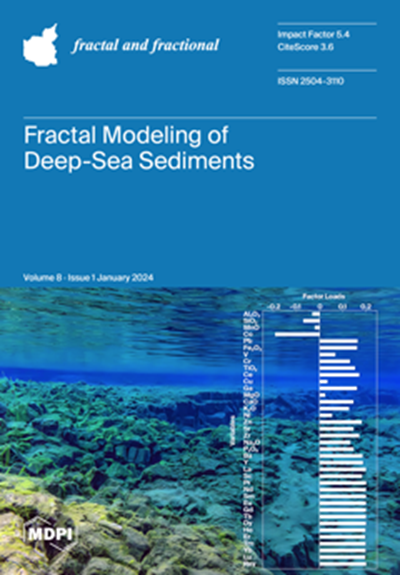Estimation of Fractal Dimension and Segmentation of Brain Tumor with Parallel Features Aggregation Network
IF 3.6
2区 数学
Q1 MATHEMATICS, INTERDISCIPLINARY APPLICATIONS
引用次数: 0
Abstract
The accurate recognition of a brain tumor (BT) is crucial for accurate diagnosis, intervention planning, and the evaluation of post-intervention outcomes. Conventional methods of manually identifying and delineating BTs are inefficient, prone to error, and time-consuming. Subjective methods for BT recognition are biased because of the diffuse and irregular nature of BTs, along with varying enhancement patterns and the coexistence of different tumor components. Hence, the development of an automated diagnostic system for BTs is vital for mitigating subjective bias and achieving speedy and effective BT segmentation. Recently developed deep learning (DL)-based methods have replaced subjective methods; however, these DL-based methods still have a low performance, showing room for improvement, and are limited to heterogeneous dataset analysis. Herein, we propose a DL-based parallel features aggregation network (PFA-Net) for the robust segmentation of three different regions in a BT scan, and we perform a heterogeneous dataset analysis to validate its generality. The parallel features aggregation (PFA) module exploits the local radiomic contextual spatial features of BTs at low, intermediate, and high levels for different types of tumors and aggregates them in a parallel fashion. To enhance the diagnostic capabilities of the proposed segmentation framework, we introduced the fractal dimension estimation into our system, seamlessly combined as an end-to-end task to gain insights into the complexity and irregularity of structures, thereby characterizing the intricate morphology of BTs. The proposed PFA-Net achieves the Dice scores (DSs) of 87.54%, 93.42%, and 91.02%, for the enhancing tumor region, whole tumor region, and tumor core region, respectively, with the multimodal brain tumor segmentation (BraTS)-2020 open database, surpassing the performance of existing state-of-the-art methods. Additionally, PFA-Net is validated with another open database of brain tumor progression and achieves a DS of 64.58% for heterogeneous dataset analysis, surpassing the performance of existing state-of-the-art methods.利用并行特征聚合网络估算分形维度并分割脑肿瘤
准确识别脑肿瘤(BT)对于准确诊断、制定干预计划和评估干预后的效果至关重要。人工识别和划定 BT 的传统方法效率低、易出错且耗时。由于 BT 的弥漫性和不规则性,以及不同的增强模式和不同肿瘤成分的共存,主观的 BT 识别方法存在偏差。因此,开发 BT 自动诊断系统对于减少主观偏差、实现快速有效的 BT 分割至关重要。最近开发的基于深度学习(DL)的方法取代了主观方法;然而,这些基于深度学习的方法性能仍然较低,有改进的余地,而且仅限于异构数据集分析。在此,我们提出了一种基于 DL 的并行特征聚合网络(PFA-Net),用于对 BT 扫描中的三个不同区域进行鲁棒分割,并进行了异构数据集分析以验证其通用性。并行特征聚合(PFA)模块利用不同类型肿瘤的 BT 在低、中、高三级的局部放射学上下文空间特征,并以并行方式对其进行聚合。为了增强所提出的分割框架的诊断能力,我们在系统中引入了分形维度估计,并将其作为端到端任务无缝结合,以深入了解结构的复杂性和不规则性,从而描述 BT 错综复杂的形态特征。在多模态脑肿瘤分割(BraTS)-2020 开放数据库中,所提出的 PFA-Net 对增强肿瘤区域、整个肿瘤区域和肿瘤核心区域的 Dice 分数(DSs)分别达到了 87.54%、93.42% 和 91.02%,超过了现有先进方法的性能。此外,PFA-Net 还在另一个脑肿瘤进展开放数据库中进行了验证,在异构数据集分析中的 DS 达到了 64.58%,超过了现有先进方法的性能。
本文章由计算机程序翻译,如有差异,请以英文原文为准。
求助全文
约1分钟内获得全文
求助全文
来源期刊

Fractal and Fractional
MATHEMATICS, INTERDISCIPLINARY APPLICATIONS-
CiteScore
4.60
自引率
18.50%
发文量
632
审稿时长
11 weeks
期刊介绍:
Fractal and Fractional is an international, scientific, peer-reviewed, open access journal that focuses on the study of fractals and fractional calculus, as well as their applications across various fields of science and engineering. It is published monthly online by MDPI and offers a cutting-edge platform for research papers, reviews, and short notes in this specialized area. The journal, identified by ISSN 2504-3110, encourages scientists to submit their experimental and theoretical findings in great detail, with no limits on the length of manuscripts to ensure reproducibility. A key objective is to facilitate the publication of detailed research, including experimental procedures and calculations. "Fractal and Fractional" also stands out for its unique offerings: it warmly welcomes manuscripts related to research proposals and innovative ideas, and allows for the deposition of electronic files containing detailed calculations and experimental protocols as supplementary material.
 求助内容:
求助内容: 应助结果提醒方式:
应助结果提醒方式:


